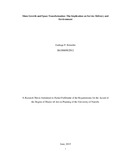Slum growth and space transformation: the implication on service delivery and environment
| dc.contributor.author | Gathogo, P Kimotho | |
| dc.date.accessioned | 2015-09-02T08:11:29Z | |
| dc.date.available | 2015-09-02T08:11:29Z | |
| dc.date.issued | 2015 | |
| dc.identifier.uri | http://hdl.handle.net/11295/90336 | |
| dc.description | Thesis | en_US |
| dc.description.abstract | This research study investigated slum growth and transformation and the associated implications on the environment and service delivery in Mukuru Settlement between September 2013 and October 2014. The study particularly sought to quantify the spatial growth of the Mukuru slums and establish whether there has been any change in character in the slum ultimately establishing the implications this growth has had on service provision and on the environment. Aerial photographs of 1978 and 1998 were used together with a Quick Bird Satellite image with a 1meter resolution being used to quantify growth and assess change in character. A field survey was then conducted using a sample size of 195 with the household being the target. Data was analysed using SPSS statistics software and ArcGIS spatial analysis software and presented in tables and charts. The study established that the Mukuru kwa Njenga and Mukuru kwa Reuben slums have grown spatially from zero hectares in 1978 to approximately 125 hectares and approximately 77 hectares by year 2008 respectively. The study also established that there has been a change in character of the settlements which has had a positive impact on service provision with the settlements developing post-1998 having a higher access to services as compared to the settlements that developed pre-1998. In view of these findings, the study made several conclusions. First is that, the Mukuru slums developed from about 1978 with most growth seen between years 1998 to 2008. Second is that there had been a change in character of the settlement and this had a positive impact on access to services in the settlement. Thirdly is that the poor waste disposal was having a major negative impact on Ngong’ river. The study therefore recommended that the solution to the identified problems lie in proper planning of the settlement by ensuring proper implementation and enforcement of prerequisite laws. It recommended that youths in these settlements should be empowered and facilitated to be able to assist in delivering some of the services for example garbage collection. The study also recommended advocacy on awareness and behaviour change on waste disposal methods. | en_US |
| dc.language.iso | en | en_US |
| dc.publisher | University of Nairobi | en_US |
| dc.title | Slum growth and space transformation: the implication on service delivery and environment | en_US |
| dc.type | Thesis | en_US |
| dc.type.material | en_US | en_US |

